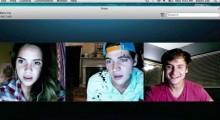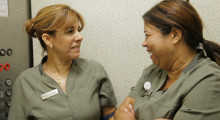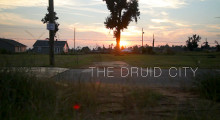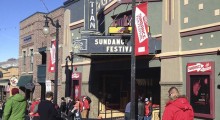Canon 5D
-
How to Fake a Movie That Takes Place Entirely on a Laptop: DP/Producer Adam Sidman on Unfriended

My gripe with most found footage horror films is that the subgenre strips away so many of a filmmaker’s paintbrushes in the name of verisimilitude. Score, editing, composition and lighting are sacrificed at the altar of faux reality. Unfriended strains under some of those same constraints, but the film diverges in the way it uses perspective. Instead of limiting point of view to a single shaky handheld camera wielded by one of the characters, Unfriended unfolds entirely on the Mac laptop of Blaire, a high schooler who, along with five or her friends, is terrorized by the spirit of a […]
by Matt Mulcahey on Aug 13, 2015 -
Five Questions for Twenty Feet from Stardom Cinematographer Nicola Marsh

Nicola Marsh was one of two cinematographers for Twenty Feet from Stardom, this year’s Oscar winner for Best Documentary. She’s worked with director Morgan Neville on a number of projects, including Troubadours and The Night James Brown Saved Boston as well as other directors including Cameron Crowe on Pearl Jam Twenty and The Union. Marsh, who has just finished shooting a reality show in the Caribbean, spoke to us about shooting Twenty Feet from Stardom, the different cameras used on the project and the hidden strengths of older lenses. Filmmaker: For Twenty Feet from Stardom you were shooting with […]
by Michael Murie on Mar 26, 2014 -
Natalia Leite and Alexandra Roxo on VICE’s Every Woman

More often than not, filmmakers undertake the odd job to get by — not unlike, as Natalia Leite and Alexandra Roxo argue in their VICE series Every Woman, the storied “second sex.” “We started thinking about the most stigmatized, mysterious and hardest jobs women do,” Roxo narrates in the opening sequence. And so, the Brooklyn filmmaking team trekked across the country to slip inside the well-worn shoes (lucite heels) of a truckstop stripper, as captured in the New Mexico-set pilot of Every Woman. Filmmaker spoke with Leite and Roxo about the series, the dangers of overstepping exploitative bounds and the foibles of simultaneously acting […]
by Sarah Salovaara on Jan 31, 2014 -
Which Camera for Which Genre? Five Questions for D.P. Timur Civan

As an undergrad at NYU, Timur Civan studied sculpture before moving into video. “I became really interested in video because I was able to bring time into my sculptural work,” he says. Civan has produced a wide variety of work, from short films, music videos, and corporate videos, to commercials and documentaries. He recently DP’d Vincent Laforet’s intro for the M?VI digital 3-axis gyro-stabilized camera gimbal. He has an affinity for experimenting with unusual gear, and finding new in-camera effects. Civan spoke to us briefly at a recent presentation he gave at Rule Boston Camera: Filmmaker: How did you first get […]
by Michael Murie on Jun 26, 2013 -
Councilwoman Castillo: Margo Guernsey on Making Her Feature-Length Political Documentary

Margo Guernsey has produced promotional mini-docs and videos for a number of non-profits, but for her first feature-length project, “Councilwoman Castillo,” she is focusing on the story of a hotel housekeeper, Carmen Castillo, elected to the City Council in Providence, Rhode Island. The project will cover Castillo’s first three years in office starting with her election in November 2011. Guernsey spoke to us recently about how she became interested in the project and her strategy for shooting and funding this low budget, multi-year project. Filmmaker: What is the story? Guernsey: It’s a story about a hotel housekeeper elected to […]
by Michael Murie on May 29, 2013 -
The Druid City: Interview with Kristyn Ulanday and Max Esposito

Kristyn Ulanday and Max Esposito graduated from the journalism department of Boston University in 2010. They both work commercially as freelance photographers and filmmakers, but in 2011 they also began a collaborative project called Full Frame America to tell the stories they wanted to tell. The first result of that collaboration is a 24-minute documentary, The Druid City, that focuses on the town of Tuscaloosa, Alabama and how the residents have coped after the town was hit by an EF4 tornado in April 2011. Filmmaker: How did you come to make this movie? Esposito: We both felt like we […]
by Michael Murie on Apr 29, 2013 -
Festival Cinematography Notes – At Sundance, Alexa Rising

The day Sundance began, Daily Variety’s lead article kicked off with: “In this brave new indie world of VOD, shifting release windows, RED cameras [italics mine] and social media marketing…” I was struck by how little any of this has to do with indie filmmaking alone. As a token of digital revolution, RED cameras are so five years ago. It’s hard to storm the ramparts when last year’s #5 and #7 box office hits were shot with RED Epics (The Hobbit: An Unexpected Journey, The Amazing Spider-Man). In fact, not only were last year’s #1 and #4 hits filmed with […]
by David Leitner on Feb 5, 2013 -
Documentary Production at Frontline: An Interview with Tim Mangini
Tim Mangini is the Director of Broadcast for WGBH’s Frontline. His overarching role is to make sure the programs get made and that they get made on time, on budget, and that the quality level meets Frontline’s expectations. Tim began his career working in animation and sound in Hollywood, then came back to Boston and worked in the corporate and broadcast video world before joining WGBH in 1995 as a post-production supervisor. One of his roles as Director of Broadcast is to work with producers to identify the equipment they need to capture their vision. We recently spoke to him […]
by Michael Murie on Aug 28, 2012 -
Jess + Moss — A Hammer to Nail Review
(Jess + Moss world premiered at the 2011 Sundance Film Festival. It opens theatrically at the reRun Gastropub in New York City on Friday, February 17, 2012. If you are not in NYC, don’t worry, as it is now available on VOD at the following outlets: YouTube, iTunes, Sundance Now, and Amazon. Visit the film’s official website to learn more.) While there are many pressing existential questions, to my mind, this is one of the most significant: can one make a truly effective film about aimlessness and boredom without that film becoming excruciatingly aimless and boring in its own right? […]
by Michael Tully on Feb 16, 2012 -
Is Shallow Depth-of-Field a Fad?

Most creative arts suffer from trends. Someone does something new or unusual, and suddenly dozens of others are imitating it; just look at Hollywood. Since the arrival of the Canon 5D Mark II, shallow depth-of-field has become almost a fetish. There’s certainly valid reasons to want to have shallow depth-of-field, as filmmaker Stu Maschwitz wrote on his blog: “With a 5D Mark II, its sensor double the size of a motion picture film frame, we can achieve cinematic focus at F4. We can get fetishistically shallow depth of field at F2.8. At F1.2, we can create abstract art in a […]
by Michael Murie on Dec 8, 2011
